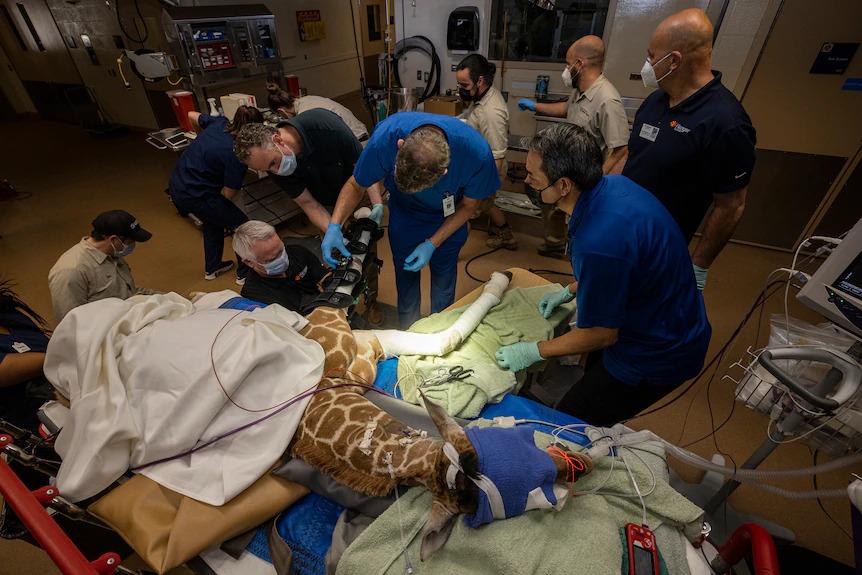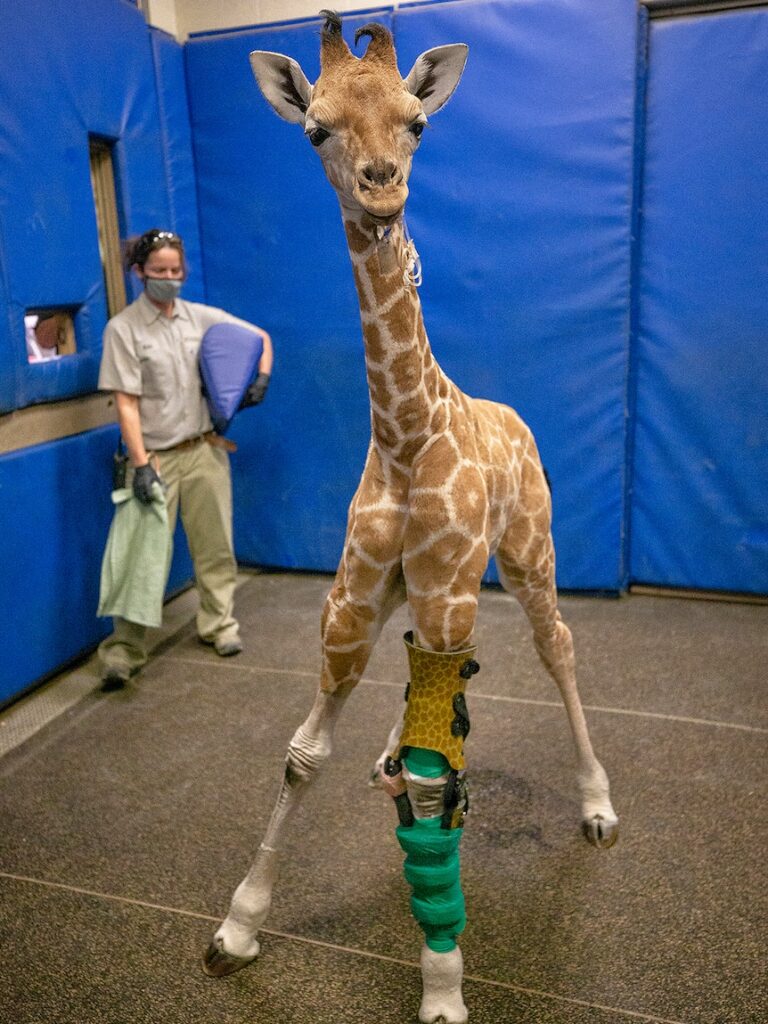
To assist a young giraffe born in a US zoo with a life-threatening limb ailment walk, she was equipped with tailored, human medical-grade leg braces.
Msituni was born with her front limb bending the wrong way on February 1 at the San Diego Zoo Safari Park in Escondido, north of San Diego.
Staff at the safari park feared she would die if the ailment was not treated quickly, since it would prevent her from breastfeeding and wandering around the environment.
They have no expertise, however, in bracing a young giraffe.
That was especially difficult since she was a 178-centimetre infant who was getting taller by the day.
So they turned to orthotics experts at the Hanger Clinic, where Ara Mirzaian got his first animal patient.
Ara Mirzaian has fitted braces for everyone from paralympians to youngsters with scoliosis over the last three decades, but never animals, much alone a baby giraffe.

“When I first heard about it, it was quite bizarre,” Mr Mirzaian told The Associated Press last week on a trip to see Msituni, who was strutting alongside the other giraffes with no problems.
“Of course, all I did was go online and study giraffes for like 24/7 until we got out here.”
In order to discover solutions for sick animals, zoos are increasingly turning to medical specialists who treat people.
In the realm of prosthetics and orthotics, the partnership has proven very beneficial.
ZooTampa in Florida collaborated with comparable specialists earlier this year to successfully replace a cancer-stricken great hornbill bird’s beak with a 3D-printed prosthesis.

Vets seeking outside help
In 2006, the Hanger Clinic developed a prosthesis for a Florida bottlenose dolphin who had lost his tail after being trapped in crab trap ropes. Their narrative was adapted into the 2011 film “Dolphin Tale.”
But it was a steep learning curve for everyone, including Matt Kinney, the senior veterinarian in charge of Msituni’s care at the San Diego Zoo Wildlife Alliance.
“We frequently use casts, bandages, and other similar devices. But anything as elaborate as this brace, which she was given, was something we had to rely on our human [medical] colleagues for “Mr. Kinney explained.
Msituni had hyperextended carpi, which are wrist joint bones in giraffes’ front limbs that resemble arms.
The second front leg began to hyperextend as she overcompensated. Her back leg joints were likewise weak, but specialized hoof extenders were able to help.
Her anomaly was already taking its toll on her joints and bones, considering that she weighed more than 55 kilos at birth.

Braces from the store aren’t up to par.
Mr Kinney originally bought post-surgery knee braces at Target, which he chopped up and re-sewed, but they kept falling off while the bespoke braces were being made.
Msituni then wore human-grade braces that were customized to fit her lengthy legs. Msituni, though, ultimately shattered one.
Hanger Clinic collaborated with a business that creates horse braces to create personalized braces with a range of motion while remaining sturdy.
The carbon graphite braces, which featured the animal’s peculiar pattern of misaligned spots to match her fur, took eight days to manufacture using cast mouldings of the giraffe’s legs.
Mr Mirzaian explained, “We added on the giraffe design just to make it enjoyable.”
“We do this with kids all the time. They get to pick super-heroes, or their favourite team and we imprint it on their bracing. So why not do it with a giraffe?”
Msituni just required one brace in the end. With the medical-grade brace, the other leg straightened itself.
Mr Mirzaian was so struck by the animal’s beauty that he hugged her when they put her under to install the special brace.
“Seeing such a massive, magnificent beast simply resting there in front of me was absolutely wonderful,” he added.
Msituni is now able to interact with other giraffes.
The condition was resolved after ten days with the bespoke brace.

She was in braces for 39 days from the day she was born, and she spent the entire time at the animal hospital.
Following that, she was gradually introduced to her mother and other members of the herd. Her mother never returned her, but she has been adopted by another female giraffe, and she now goes about with the other giraffes.
Mr Mirzaian aims to display a photograph of the baby giraffe wearing her patterned brace so that the children he treats will be motivated to do the same.
“Seeing an animal like that walk in a brace was the greatest thing,” he remarked.
